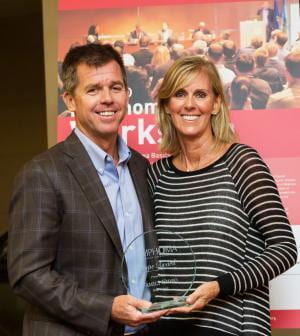The Story of the Biobank
Sonali Smith, MD, director of the University of Chicago Medicine Lymphoma Program, remembers exactly when the Hoogland Lymphoma Biobank was born. She had just met Family Video President Keith Hoogland—they had been connected through the Lymphoma Research Foundation, on whose board Hoogland serves—and found in him the same singularity of purpose she feels herself. “His whole quest is: how do we get rid of this disease?” she says. “What do we need to do? Why is progress so slow?”
One limiting factor is access to tissue. Standard treatment for many cancers involves surgery, and many patients are happy to give their extra excised tumor tissue to be used in research. This creates a supply of cancerous tissue for doctors and scientists to study, in order to determine how it is different from normal tissue, how it grows and develops, and how to design treatments that target its specific characteristics. “The only way you can make discoveries is by looking at the tissue,” says Dr. Smith.
But surgery is not part of the normal treatment plan for lymphoma. For most patients, the only tissue sample comes from a diagnostic biopsy—which has frequently been archived by the time a patient, some number of referrals and opinions later, arrives in our clinic. “It’s often not in the patient’s best interest to have another biopsy,” says Dr. Smith. “It makes the initial tissue very precious.”
In their very first conversation, Dr. Smith and Mr. Hoogland sketched out the way forward: a biobank that would hold involve both storing lymphoma tissue and cataloguing it with epidemiological data—information about the patient, the course of treatment, and outcomes. This would allow researchers to discover both diagnostic clues and targets for future research. If, for example, patients with a certain mutation respond better to a certain chemotherapy regimen, then doctors can use that information immediately in developing diagnostic guidelines, while scientists can examine this mutation to figure out why it affects chemotherapy response.
Mr. Hoogland formed a plan of his own. His company, Family Video, hosts an annual fundraiser called Round it Up for Lymphoma, in which customers “round up” their purchase to the next dollar and donate the change to lymphoma research. Mr. Hoogland knew that this program was just the thing to get the Hoogland Lymphoma Biobank moving. “They are perhaps one of the most dedicated families to this cause that I have ever met,” says Dr. Smith. “They know that progress will be made if resources are put in the right place.”
Since 2011, Round It Up for Lymphoma has raised more than $6.9 million for the Lymphoma Research Foundation and the University of Chicago Medicine—but the story of the Hoogland Lymphoma Biobank is just beginning. If you are a patient, a lymphoma researcher, a doctor, a donor, a family member, or a friend: join us. Together, we will pursue the hardest questions in lymphoma research—and, most importantly, answer them for lymphoma patients around the world.

Keith and Susan Hoogland
